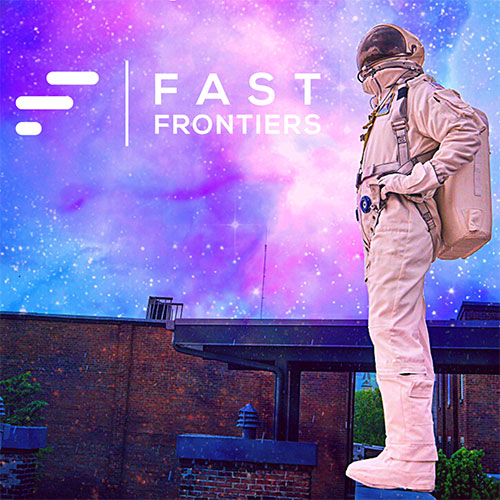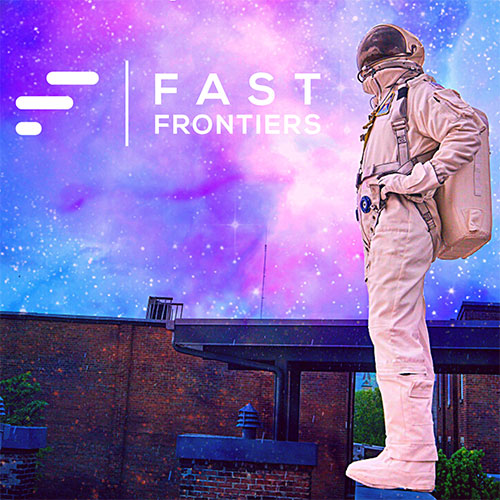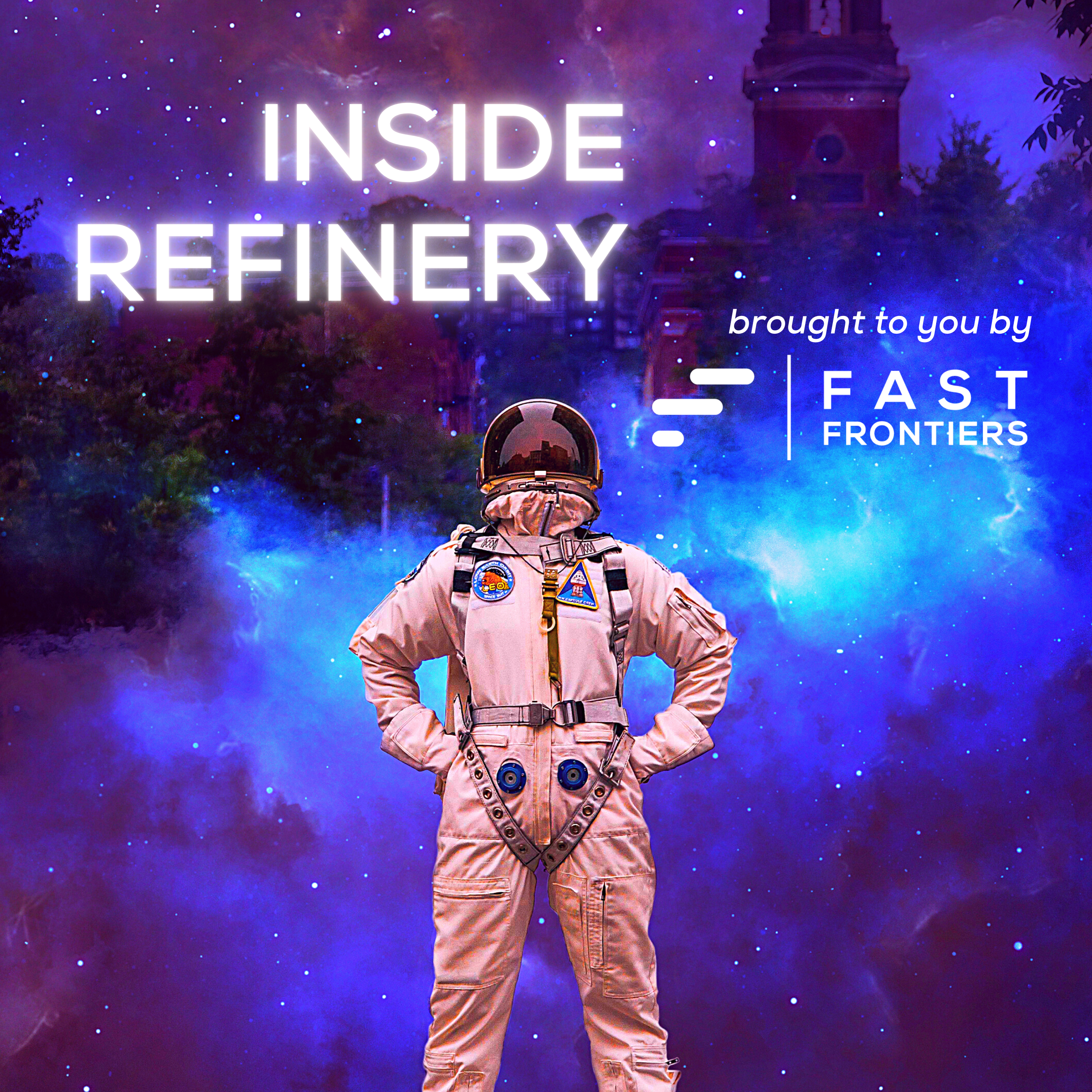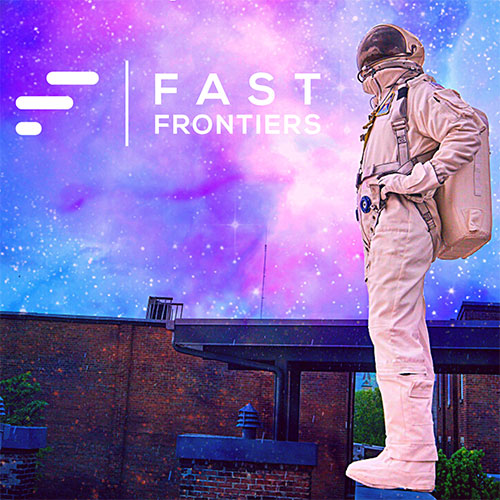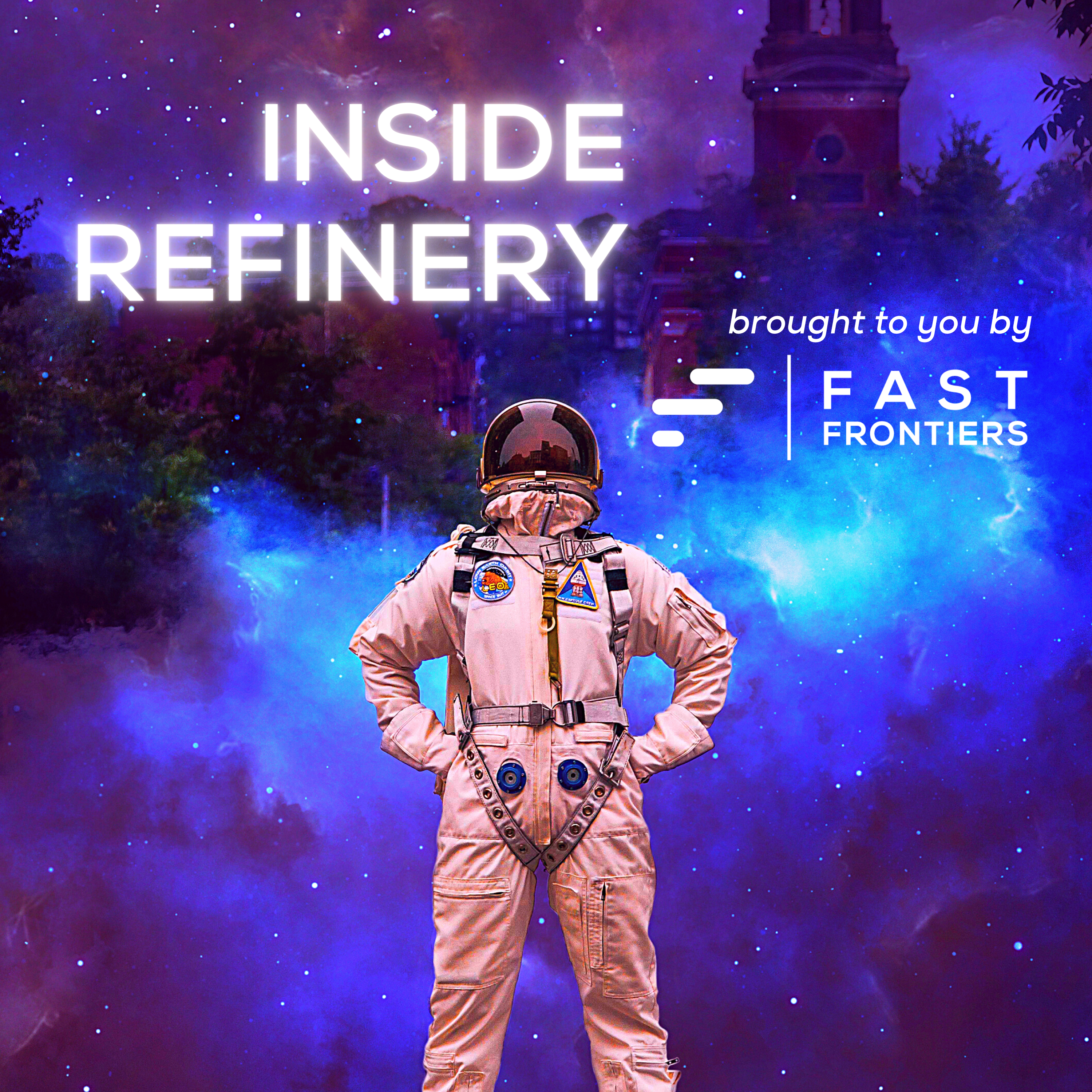S5 Ep 1. Brian Cobb: Chief Innovation Officer at CVG airport
- 0.5
- 1
- 1.25
- 1.5
- 1.75
- 2
Tim Schigel: Welcome to Fast Frontiers. I am your host, Tim Schigel, Managing Partner of Refinery Adventures. Today we're talking with Brian Cobb, Chief Innovation Officer for the Cincinnati Northern Kentucky International Airport, also known as CVG. And if you haven't been to Cincinnati, you don't realize that the CVG airport's actually in Covington, Kentucky, therefore CVG. In this episode, we're going to dive into the competition for a regional airport. In this case, CVG happens to be surrounded by 5 others with within an hour and a half drive. And they decided to stand out by focusing on innovation and tackling one of the biggest problems that nobody wanted to own, which was the long lines in security. We're also going to discuss what the next 10 years are going to look like in this space with autonomous vehicles, machine learning, vertical takeoff and landing aircrafts. The biggest theme, or so what I hope to take away from this is, the surprising places where innovation is having an impact. Brian and his team at CVG are doing an amazing job, welcoming all startups to come in and find out ways that they can improve the experience for the airlines and the passengers. Please enjoy my conversation with Brian Cobb. Welcome Brian to Fast Frontiers. So excited to have you here today.
Brian Cobb: Excited to be with you, Tim. Great to see you again.
Tim Schigel: This may not be obvious that we're having somebody from an airport on Fast Frontiers to talk about innovation, right? But what you're doing there is super fascinating and being from the region, we're a little bit more familiar, but I'd love to have others learn about what you're doing and see the opportunities as we have, including for some of our own portfolio companies, which is terrific. Before we get into that, let's talk a little bit about how you got here, your personal journey to where you are today.
Brian Cobb: Yeah. Thanks. And first, Tim, thanks to you and your team for inviting CVG to share our story. Particularly on the innovation front. It has been a wild ride, professionally and personally. On the personal side, I ended up on the innovation front really by happenchance. So my career has always been in aviation. First 20 years on the airline side, the last 10 years, 11 years on the airport side, but really roughly about 10 years as I was coming into the airport, we had some circumstances where CVG locally, we went through some really difficult times. The local folks will remember those difficult times. And we had to, from the customer services side of the house, we had to take on more responsibility. And that was just simply, you know, we had so much competition in the area from other airports, unlike anywhere else in the US, there are 5 other airports, right on top of CVG, all within an hour, hour and a half drive. So it's just not anything like that anywhere else in the US. So competition is fast and furious. So when the market fell out, CVG really suffered from being a dominant hub. And then suddenly we didn't have any low cost carriers. And, and really we had to look around us and say, what are we? And do we even have a brand? Do people even know what we are? And we were very much viewed as one particular airline at the time. And we had to change our business practices and really the innovation piece came about by happenchance. And it was looking at the security checkpoint. You probably actually experience this. So back in the day we had opened up a brand new security checkpoint. It was beautiful, but unfortunately we had wait times of about 45 minutes to 60 minutes. It was your unfortunately typical wait time. Typical TSA security wait time. Very frustrating to the consumer. From a customer experience out of the house, first judgment of any airport is typically your experience of security. So, we were not being judged well. And, of course, that was the early days of social media, definitely Twitter. So, we were getting crosstalk on Twitter. That wasn't self- sustaining. And if we looked at who was taking responsibility, well, TSA, wasn't going to take responsibility for their product. And frankly, I don't know that they knew that they have a product. Because it's, we're the government and we do a job and that's it. And on the airline side, it was viewed very much of, well, that's not really our gig. We just process people at the ticket counter. So no one was taking responsibility. We, as the airport stepped in and we said, well, we're going to take a different inaudible. We're going to be the ombudsman. We're going to take the middle approach. And we sourced and frankly found new technology that was in Europe for retail purposes. It was also used outdoor for roadway purposes. And it was just simply wifi, Bluetooth, Sniffer. And we turned it on and we started sniffing for Bluetooth signals on cellular devices. We didn't know who the customer was. We still don't. We still use it today. And we just started plotting dots on a map. So point A, point B, time difference between the two and that's the average wait time. And from that, we are able to share, here's what the average wait time is. And we are able to show that on a basic monitor. We were the first airport in the country to be able to do that. And, of course, now that's very commonplace across the country and frankly, around the world. So, not only did we share that with the consumer and alleviate really the fear of the unknown, but then also because we were measuring, we were holding people accountable just by sharing data. So mysteriously our wait time numbers just continue to creep down. And I kid you not when I say our social media hate went away overnight.
Tim Schigel: If you just start to publish the numbers, make them transparent and provided they're the right numbers, right? Not every number matters. You get the right numbers published to people, you don't need to say much. People just start going, oh yeah, that could be better. That can be better.
Brian Cobb: Well, in that case, at a security wait point, you've probably been in this situation, your perception of time might be different from my perception of time, especially if you're angry and you've had a bad experience trying to park or a frustrating issue, you spilled coffee on you. So, monumental things add up. So, in a simple situation where if we just provides some basic information on all sides, employee and consumer, we alleviate just the fear of the unknown. So something so simple from a technology perspective and our own talents really came together to demonstrate that gee, some basic technology differences can really make a tremendous difference on the experience side.
Tim Schigel: So to get to that point, though, first of all, as you met mentioned, you were facing this adversity and you were dealing with a inherent limitation, meaning you're in a region where there's other competitive airports and it forced you to overcome that or use some of those weaknesses as strengths and start on this innovation journey, talk about as a larger organization, how did you get that alignment throughout your leadership?
Brian Cobb: So we're very fortunate from the perspective of having a CEO like Candace McGraw, that essentially gave us a whiteboard and said, okay, clearly that was successful. You were audacious enough to go outside industry. And let's face it, aviation is, we're archaic in our approach, very reluctant to go outside industry. We just like to go to the aviation depot and pool, the same solution off the shelf and if it worked for one airport, it's got to work for all airports, right? That's just simply not the case. And we have been blazing a trail since that really demonstrates first and foremost, no, one size doesn't fit all. And if you've seen one airport, that doesn't mean that you've seen all airports. And particularly in our case, we were a major hub at one point. And frankly we understand our position now, our lot in life, that we're really a midsize airport now on the customer side and on the scheduled passenger side. We're really a mega hub on the cargo side. And that's a different story that we'll get to. But on the passengers side, we know our place. So from that perspective, we're agile enough from that mid- size perspective that we can go out and we can test a new product and we can really work with new companies that haven't played in the aviation space before, and we can teach them about aviation. So, we don't have to go to the same solution oriented, same aviation oriented businesses. And frankly a company that you and I are very familiar with and something that you really originated is Centrifuge. So, just the simple fact of us going abroad and finding a solution in Europe, I recognized I can't keep going to Europe for the solution, frankly. And another aspect internally and personally is I grew up in Cincinnati. So something near and dear to my heart was how can our airport give back to the community. And knowing that, Hey, there's tech advances out there and there's significant talent in the tech space, right in our own backyard, what company around here just can expose us to this talent. And frankly, it was Centrifuge. So I just signed up as a mentor thinking that maybe I could offer something. Well, I got far more back than what I could offer as a mentorship.
Tim Schigel: That's been terrific to see. And you have Nasharm Marks, shout out to her joining from the Centrifuge team. But you have been very welcoming to startups and their technologies and integrating them and actually just putting them to use, which I think is amazing and is a good, a great example from other large organizations to say, try this stuff, test, work with some of these companies. It's not all going to work necessarily, right? But you both learn a lot. And I imagine, I mean, I know the startups appreciate it, for sure. But, you just talk about, how do you manage that, in terms of finding out more about where those companies or those technologies are and how to bring them in and test them. What's that process look like?
Brian Cobb: Well, I think you really kicked it off that when we started of why are we talking to an airport? And frankly, that's the usual conversation when I go to the valley of, why in the hell are we talking to an airport guy? This is unusual. Definitely we found ourselves as really this incubator space. And we have simply taken our 7, 700 acre campus and turned it into this massive laboratory. And our pitch, our approach is, look, we take this laboratory and we open it up and we sit across the table from you as a startup. And we ask you, what is your product? And it doesn't have to be aviation related. And as you're telling us what your product is, our wheels are spinning to see, well, can it play in the aviation space? And does it have a spot that we can bring it into? And if it does, and we have that ideation point that we can strike on, then we'll share it with you. And we'll say, well, what if, and frankly, we immediately we get into a spitball session. So what's really unusual about us is we typically don't have conversations that start off with a problem statement. And that really throws people for a loop. We don't specifically go source startups based on a problem statement. It's more about come one, come all, a lot of word of mouth, lot of connections of, Hey, I met this person. You would be interested in connecting with this person.
Tim Schigel: That's interesting. So you're open to those collisions and unexpected ahas, if you will, the what ifs, instead of just saying, Hey, we're solely limited. We have blinders on, we know this is the problems. This is what we need to solve for, period. With the goal, I imagine, just like you talked about with the wait lines, reducing friction, reducing friction for passengers, potentially reducing friction for airlines, et cetera.
Brian Cobb: Well, really there's 3 critical parts. There's improved experience for the employee. So really we use our employee base and the employee base can be the airport board employees, like myself, the extended tenant base, the DHLs, the Amazons, the Deltas. A better work environment creates for a better customer experience. So that's step one. Then when we go past a beta, can we deliver it to the consumer directly? So, that's target number two. So an improved customer experience. Target number three, overarchingly, is revenue development. So very significant for the airport of, where and how can we develop new streams of revenue that simply don't exist today. And that's becoming more and more evident and more critical. If there was ever a shining example, and I hate to say shining under the circumstances, but COVID was like in your face, wake up of, man oh man, we've been talking about this forever. COVID was the wake up call that says, we've got to figure out new streams of revenue.
Tim Schigel: Right. So you mentioned the cargo and the logistics, and this is something that I think folks outside the region probably have no idea unless they're in the logistics business. And so yeah, for the listeners, if you're into logistics and eCommerce or anything like that, pay attention to this next part.
Brian Cobb: Yeah. Buckle up. Here we go.
Tim Schigel: Exactly.
Brian Cobb: So, an amazing story. Credit where credit is due first. So DHL, really the underdog in this whole story. DHL has been an anchored tenant at CVG for many, many years. What most people in the domestic US don't know is that DHL is actually the largest cargo carrier in the world. So yellow trucks all over outside the domestic US, you typically don't see yellow trucks on the ground a great deal in the US, you see FedEx and UPS. So, what happened in the early 2000s is DHL made a run at UPS and FedEx domestically. That didn't go so well, DHL retrenched domestically, and they shrunk, but internationally, they were still rather large. And then what happened later 2000s, well, e- commerce became a thing. This fledgling company called Amazon really became a thing beyond just selling books and then low and behold, 2016, December, Amazon decides to get into aviation. And, of course, people are like, okay, well, this is interesting. How in the hell are they going to do this? And not only did they say they're getting into aviation but they also said, they're going to do it in 6 months, which was mind blowing to anyone in aviation. You just don't get into aviation in 6 months. Like, you have to get certificates for flying aircraft and very complex. Well, how they did it was, the HLs an international company. International company can't own majority stake in US based companies. DHL was using US based sub carriers to fly DHL product in the US. So Amazon just bought majority stake or some level of stake in US certified aircraft. Immediately that's what allowed Amazon to get into aviation. And sure enough, they launched 6 months later. January, 2017, they announced CVG was going to be the first global air hub for Amazon. Fast forward to this year and Amazon has opened the first phase of a massive facility here at CVG. So, CVG Airport now is the only US airport and frankly, North American airport to have 2 major cargo companies hubbed at one location. So that is a massive claim to fame. Right now we're the seventh largest cargo airport in the US. All things being equal we can see that number dramatically reduce. Hopefully the number one in the very near term. So that would be a very good feather in our cap. Of course, that only accelerates our progress globally. Now, all that said just, you can imagine all things e- commerce accelerating during COVID. So really, if you look at Google earth, the impressive thing is not only what's happened with Amazon and DHL growth, but all of the white buildings that have built up and by white buildings, it's just new roofs around the campus of all of these logistics centers. So this has really compounded our growth strategy and the economic benefits that the airport brings to the region and accelerated all of the innovation aspects that we really have to focus on of how do we make sure that our tenant based, Amazon, DHL, continue to grow in a strategic, successful manner?
Tim Schigel: So what do you anticipate in the next 10 years are going to be the second order effects of that presence, and its impact on the region and the region's role in the technology infrastructure?
Brian Cobb: Sure. One of the immediate ones is probably autonomous vehicles. And so immediately we are the first airport in the world to actually have an autonomous vehicle operating in and around aircraft and people. Which, again, it's happening here in Cincinnati. It's hard to wrap our head around, but we've managed to pull it off. And that was from a fledgling company that came out of Seoul, South Korea, found itself in Silicon Valley. It was a little fish in a big, big pond, as you know. But great things all Ohio. Jobs Ohio lured them to the Ohio space. We had already met this company and successfully we continued to work together and grow this organization. COVID actually provided us the cover that said with Four Drive, the company, Hey, have at it. You have full access to our campus. Accelerate your product. And from an aviation perspective, a lot of companies have said, well, wait a minute, airports typically don't own this type of equipment. Why would you ever entertain this? Well, we know that number one, autonomy will be coming. Number two, we also knew before COVID we were seeing gaps in employment. So, it's not a matter of replacing jobs. We had to be concerned about just filling job gaps. So from that perspective, due diligence on our part on how do we make sure that our tenants are never in a position of falling short on employment? So great that we've got this tremendous mega hub on cargo, but if we don't have enough employees to keep this thing alive, that's not a good situation. So we accelerated the autonomous driving. That's what's happening today. Actually that company, Four Drive, poster child for a startup outside the region of how rapidly they're growing, right now, they have a massive bid underway for another large cargo company for upwards of 700 units. So if they're successful, that'll be a massive feather in their cap, huge win for CVG and a huge win for Ohio. So again, all thumbs up. But then, to your point, fast forward a little bit. Absolutely we see on the horizon vertical takeoff in landing aircraft. What's not necessarily known and I know you were part of this conversation recently, we expanded our reach into Ohio recently by picking up Oxford Airport. It's a small general aviation airport connected to Miami University, and that was strategically positioned for an innovation purpose, number one, to be able to work with the university on their innovation practices and development, but then also understanding more what was happening with general aviation and to add to our business portfolio. But then we also understand with vertical takeoff and landing new aircraft that are really rapidly coming into the marketplace, general aviation airports really could play a significant role in the future of cargo transport and the movement of people. So we don't want to be in the position of suddenly looking around our shoulders and going, oh, wait a minute. We didn't see that coming. So what a great position to be in of, university town, Amazon and DHL on the south side of our airport with cargo and why don't we trial cargo moving into the university space because we know that college kids and professors are probably ordering Amazon product. And if we can demonstrate that drone technology, then really are we not demonstrating the viability of drone capabilities, not farfetched to put passengers in it and start moving passengers to and from really challenging spaces to get them into larger municipalities.
Tim Schigel: I was also blown away on a recent little tour that we were doing in terms of this region being what, one of two for the vertical takeoff landing testing.
Brian Cobb: Correct.
Tim Schigel: Unbelievable. It's the Jetson era, for sure. And like you said, this, this little jump off between Miami university and the airport, and starting to understand autonomy in that vicinity where you also have working with regulators, right? In terms of how to use the airspace, et cetera.
Brian Cobb: From that perspective, or, wait a minute, why don't we just take a step back on autonomous vehicles? Someone actually told me, they're not toys. And that was actually a regulator at the state level.
Tim Schigel: Right.
Brian Cobb: I'm like, okay, I understand they're not toys, but we also are going to go ahead and move forward. And you're more than welcome to participate with us. Someone has to make the move. We can't necessarily afford to just sit on our heels and wait for things to happen. So there's always a first mover. Why isn't it an airport? And really the position that we take is an airport is really a micro city. Why don't we try to demonstrate it at a micro city? And if it works in a micro city, it's not farfetched to just extrapolate it out and demonstrate that it can be expanded into a metropolitan area. So, taking that and extrapolating it out, exactly what you said on the airspace side of the house. People have to remember aviation really started in a Ohio. So Ohio is reasonably hell bent to chase after the future of aviation on drone technology or advanced air mobility. So they have this consortium with NASA. We're very proud to be a part of that team and actually are the Class B airspace, the really critical, most challenging airspace that there is. So when it's time to fly drone activity in Ohio, they're actually going to come down to CVG and trial that technology through CVG's airspace. So super proud of our team for being able to be part of that consortium, especially given the fact that we're not in the state of Ohio.
Tim Schigel: I was waiting for the moment to point that out, not to overdo it, because folks in this area are probably tired of hearing it. For folks outside the area, the Cincinnati Airport, CVG stands for Covington, Kentucky, and the airport is in Kentucky, Northern Kentucky.
Brian Cobb: With the code agnostic.
Tim Schigel: Which is also represents both a limitation as well as an opportunity, right? In terms of that collaboration between the states and state lines.
Brian Cobb: It's actually provided, provided more opportunity than, than limitation and super happy to be able to share that. So we thought it would be a limiting factor. There are sensitivities around it, but once we get past the sensitivities and just bold face, let's talk about it. Let air it. It is amazing how fast people get past it and let's move.
Tim Schigel: Yeah. Well, I think the implications of the work you're doing and some of the learning that's happening being on the cutting edge here is just, it's hard to, it's hard to even imagine you know, 10 years from now, but you know you're going to be at the front because you're participating in it, right? You're learning by doing, by getting involved. And that's the first step, which I think is a really important lesson.
Brian Cobb: Machine learning is another one this past year that to your point, Centrifuge, if we were to take that building block all the way back, we met local developer Barat Senai through Centrifuge. Barat approached us with a wearable device that was really designed for medical purposes. He explained what the product was. Couldn't quite wrap our head around it. He took us to a restaurant, showed us the application of how it was being used in the restaurant space. It clicked with us, we got it and said, okay, well, here's what we're going to do. We're going to actually put it for our housekeepers. We're going to use this for our housekeepers. They're going to wear this wearable. It's a Samsung gear watch and we'll put sensor technology in our restrooms. And the whole issue is not only is the security checkpoint an indicator of the consumer experience, but our restrooms are as well. So we had experience in the restroom, your experience overall in the airport dramatically goes down. So from that perspective, 7 years ago at this point, we actually were the first airport. And from what we can tell via Samsung's research, first company in the US to actually use wearable devices for asset management, because wearables back then were really geared more towards just health purposes,
Tim Schigel: Right?
Brian Cobb: We kind of shifted the whole dynamic with a local developer and super proud of Barat. Now fast forward to today, Barat's supported by AWS with their new Panorama service. Panorama is a backend host that's AI Learning on camera technology. And essentially we have cameras looking at everything. And when we tell the cameras specifically what to look for, it's sending the watch information. So perfect example is our curb front, safety and security.` Car waits too long. It's sending one of our yellow vested agents, a notice that says car parked too long, go check it out. So, staffing efficiency see security purposes, safety purposes. And by the way, we're not always yelling at people to move their car. It's more of a, okay, there's a grace period, but by the way, you've been here too long. And it's amazing when you show a picture of their car on your watch, people do have a tendency to move. They don't argue.
Tim Schigel: That's hilarious. That hasn't happened to me yet. So that's good. I'm glad I haven't.
Brian Cobb: Don't wait too long.
Tim Schigel: Don't wait too long. That is terrific. So how should, for any entrepreneurs listening that might have some ideas that they'd like to chat with the airport about, with you about, how should they go about that?
Brian Cobb: LinkedIn is a great way to connect with me. Part One. Part Two, B Cobb, B as in Brian, C O B B @ C V G airport. com.
Tim Schigel: Awesome.
Brian Cobb: And it's just that simple, and we take it from there and usually we set up a meet and greet. Typically we want to know a little bit about the product, but then we take it exactly as we described it. It becomes really a spitball session. We try to figure out if there's a place.
Tim Schigel: That's so cool you're doing that. And I want to encourage everybody who's listening. If you have something that you want to talk about or try to reach out to Brian, for sure. And I think you'll find a very receptive audience. Brian, thank you so much for being on Fast Frontiers. Totally fascinating. Look forward to seeing everything that you guys are doing and innovating on in the future.
Brian Cobb: Very much appreciate it, Tim. It's been great to be with you.
Tim Schigel: Thanks for listening to Fast Frontiers. If you like our show and want to know more, check out our website, fastfrontiers. com. If you enjoyed this episode, please share it with others and leave us a review on your favorite podcast platform. Welcome to Season 5. Join us next week when we bring you my conversation with Ashish Delal, former founder and CEO of ParkWhiz out of Chicago, Illinois. The Fast Frontiers podcast is brought to you by Refinery Ventures. Our Producer is Abby Fitters, audio engineering by Astronomic Audio and our podcast platform is Casted.
DESCRIPTION
Chief Innovation Officer of CVG Airport, Brian Cobb, talks about his career in the aviation industry and seeking innovative solutions that have transformed the airport into a business hub. Along with host Tim Schigel, the two discuss CVG's acceptance of technology and data to solve customer perceptions, aligning with leadership towards business innovation, and the future of the airport with startup incubation and the next generation of technologies.
Today's Host

Tim Schigel
Today's Guests



